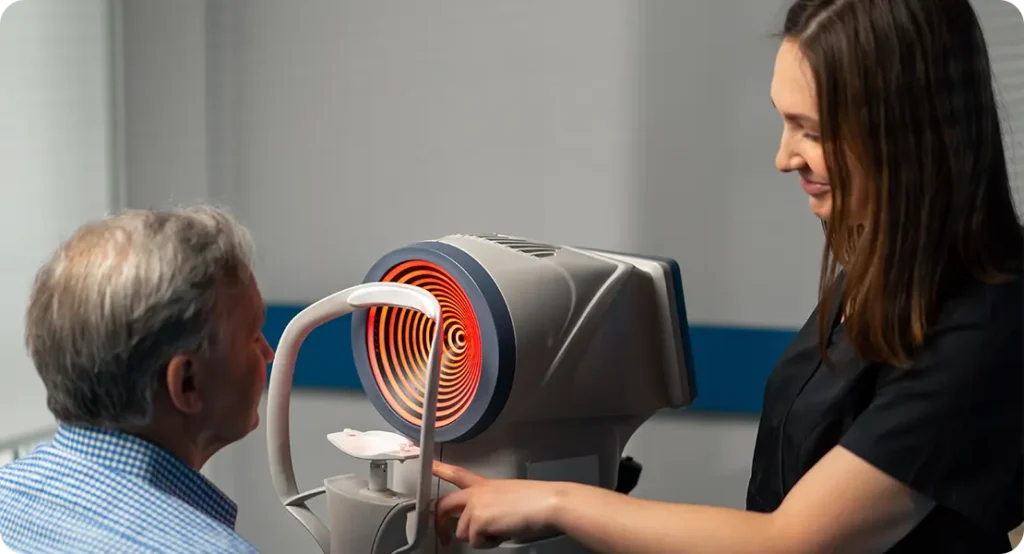If you’re preparing for cataract surgery, you’re probably focused on getting your vision back to where it once was—or even better. But here’s a question that often gets overlooked: can your gender influence how you experience the procedure, the outcome, and even how satisfied you feel with the results? It might sound surprising, but growing evidence suggests that men and women may have different journeys through cataract surgery, from pain sensitivity to preferences in intraocular lenses (IOLs), and even the final visual outcomes.
This article dives deep into the nuances of gender differences in cataract surgery. We’re not talking stereotypes—we’re talking evidence-based insights that could help improve patient care, set realistic expectations, and allow for more personalised surgical planning.
Understanding Gender in Ophthalmology: Why It Matters
For years, the medical field treated gender as irrelevant to many surgical outcomes, assuming what worked for one group would work for another. But now, we’re seeing a shift. In ophthalmology, especially in cataract surgery, researchers are beginning to pay closer attention to biological and psychological sex-related differences.
Hormones, pain perception, ocular anatomy, and even social conditioning can all subtly influence how someone responds to surgery and how satisfied they feel afterwards. When it comes to cataracts—a condition that affects both sexes but manifests slightly differently—understanding these differences isn’t just academic. It could improve outcomes and patient satisfaction.
Women generally live longer than men, and since cataracts are age-related, they make up a larger proportion of the cataract population. But longevity isn’t the whole story. Gender-specific biology and expectations can shape everything from preoperative anxiety to postoperative recovery and beyond.
Pain Perception During and After Surgery
Different Experiences of Pain
Pain is subjective, but that doesn’t mean it’s not real—or not predictable. Research consistently shows that women often report higher levels of pain than men during and after medical procedures, including ophthalmic surgeries. This isn’t because they’re more sensitive or less resilient, but likely due to complex interactions between hormones, nerve receptors, and even cultural conditioning.
For example, oestrogen has been shown to influence the sensitivity of certain pain receptors, which may explain why women might feel more discomfort during topical anaesthesia or report more dryness or stinging in the postoperative phase.
Implications for Anaesthetic Planning
If you’re a woman undergoing cataract surgery, your surgeon may opt for a more thorough preoperative discussion about discomfort management. That might mean fine-tuning anaesthetic choice or providing additional reassurance. Men, on the other hand, may under-report discomfort, leading to undertreated postoperative pain. Understanding these tendencies can help clinicians tailor pain management strategies more effectively.
Psychological Factors and Pain Reporting
Men are statistically more likely to delay reporting pain or downplay symptoms post-surgery, possibly due to traditional ideas of masculinity. Women, by contrast, may be more likely to express discomfort and seek help earlier. Recognising this allows for better postoperative care and communication with both genders.
Lens Preferences and Visual Needs
Men and Women See the World Differently
Literally. Studies have found that men and women process visual information differently. Men often have better distance vision, particularly for detecting motion, while women tend to have better colour discrimination and close-up vision. These differences are subtle, but they might influence what patients want or expect from their IOLs.
Multifocal vs Monofocal: Gender-Based Preferences
When given a choice, women are statistically more likely to choose multifocal IOLs, especially if they value independence from glasses for reading and close work. Men, meanwhile, are often more focused on distance clarity, particularly if they drive frequently or engage in outdoor activities.
This doesn’t mean all women want multifocals and all men want monofocals, but understanding the trends helps guide consultations. A well-informed discussion that takes into account your lifestyle, job demands, and visual preferences—not just your age and biometry—can make a big difference in your final satisfaction.
Satisfaction Levels and Adaptation
Interestingly, adaptation to multifocal IOLs also seems to vary slightly between genders. Some studies suggest women may be more tolerant of visual artefacts like halos, while men may be less forgiving of even minor optical imperfections. This could be linked to differing neurological responses to contrast or light scatter, but further research is ongoing.
Surgical Outcomes and Complication Risks

Biometric Differences in the Eye
On average, men tend to have longer axial lengths and deeper anterior chambers, while women typically have steeper corneas and shallower anterior chambers. These anatomical variations aren’t just academic—they affect surgical planning and IOL power calculations.
A shorter axial length, more common in women, is associated with a higher risk of postoperative refractive surprise and may require more precise biometry. Surgeons need to account for these variables during IOL selection and calculation.
Postoperative Complications: Are the Risks the Same?
Some research indicates that women may have a slightly higher risk of dry eye symptoms after cataract surgery, particularly if they already had pre-existing ocular surface issues or are postmenopausal. Men, on the other hand, may be more prone to delayed reporting of visual issues or discomfort.
When it comes to serious complications like posterior capsule rupture or cystoid macular oedema, gender doesn’t appear to play a major role—but ongoing studies continue to explore whether hormonal status or systemic conditions (like autoimmune diseases) that differ by gender could influence outcomes.
Hormonal Influence on Healing and Inflammation
The Role of Oestrogen and Testosterone
Oestrogen plays a role in tear production, inflammation modulation, and tissue healing. Postmenopausal women—who make up a large part of the cataract surgery population—often experience hormonal changes that reduce ocular surface integrity. This can result in more pronounced symptoms of dryness, grittiness, and delayed epithelial healing.
Men, on the other hand, may benefit from more stable levels of testosterone, which is also implicated in meibomian gland function and tear film quality. The hormonal landscape, then, is another factor that subtly shapes recovery experiences.
Gender-Specific Risks and Systemic Health
Women are more likely to have autoimmune conditions such as Sjögren’s syndrome, which directly affects tear production. They’re also more likely to be on medications that impact wound healing (like corticosteroids for rheumatologic disease). Men, conversely, may present with metabolic syndrome or cardiovascular risks that require different perioperative considerations.
Psychological Expectations and Satisfaction
Men and Women Approach Surgery Differently
The psychological approach to surgery varies by gender. Women tend to seek more information, ask more questions, and may be more anxious prior to surgery. But they also tend to have higher satisfaction scores postoperatively, particularly when expectations are managed well.
Men may approach the surgery more pragmatically but can be more vocal if outcomes don’t meet their expectations—particularly with regard to sharpness and clarity in distance vision.
Tailoring the Conversation
For clinicians, this means the way information is presented and discussed can make a big difference. For women, it might mean providing more detailed reassurance, education on dry eye symptoms, and follow-up support. For men, focusing on performance, contrast sensitivity, and avoiding unwanted visual artefacts may carry more weight.
Either way, customising the conversation helps build trust—and ultimately leads to better outcomes.
Training and Research Gaps: What Needs to Change?
There’s still a long way to go when it comes to gender-focused research in ophthalmology. Most large trials don’t stratify by sex, and very few studies explore how lens choice or surgical technique might affect men and women differently in the long term.
Training curricula for surgeons also tend not to address gender as a variable in surgical planning or outcomes. This needs to change if we’re to move towards more personalised, evidence-based care.
FAQs
- Do men and women experience cataract surgery pain differently?
Yes, studies suggest that women may report higher levels of discomfort during and after cataract surgery compared to men. This difference is thought to be influenced by hormonal variations—particularly oestrogen—which can affect how pain is processed. That said, everyone’s experience is personal. The key is to communicate openly with your surgeon so pain relief can be adjusted to suit your needs, regardless of gender. - Are certain types of intraocular lenses (IOLs) better suited to women or men?
Not exactly, but preferences can differ. Women often lean towards multifocal IOLs, especially if they want to reduce reliance on reading glasses for close work. Men, on the other hand, may prioritise sharp distance vision, making monofocal IOLs more appealing. The right choice depends on your lifestyle, not your gender—but understanding these trends can help guide a more personalised discussion. - Is dry eye more common in women after cataract surgery?
Yes, women—particularly postmenopausal women—are more likely to experience dry eye symptoms following cataract surgery. This is largely due to hormonal changes that affect tear production and ocular surface health. If you already suffer from dryness, make sure your clinic addresses this before surgery, as proactive treatment can reduce discomfort and improve healing. - Can gender affect how satisfied someone feels after cataract surgery?
Absolutely. Research shows that women may have higher satisfaction levels overall, but they often seek more information before surgery and value detailed aftercare. Men might focus more on performance metrics like visual sharpness and may be more vocal if expectations aren’t met. The takeaway? Clear communication and tailored counselling are vital for both genders. - Do anatomical differences between men and women affect the surgery itself?
They can. On average, women tend to have steeper corneas and shorter axial lengths, which can influence IOL power calculations and surgical planning. Men often have longer eyes and deeper anterior chambers. These differences aren’t drastic, but they matter—especially when aiming for precise refractive outcomes. - Is there a difference in how quickly men and women recover from cataract surgery?
Recovery timelines are generally similar for both genders, but individual factors like hormone levels, tear film quality, and general health can subtly influence healing. For example, women with hormone-related dry eye may take slightly longer to feel fully comfortable, while men might delay reporting issues, which can slow intervention. - Should gender be considered during preoperative planning for cataract surgery?
Yes, and the best clinics already do. While the core surgical steps remain the same, a gender-sensitive approach considers pain tolerance, lens preferences, hormonal influences, and patient communication styles. This doesn’t mean making assumptions—it means asking the right questions to create a truly customised surgical plan.
Final Thoughts: Why This Matters for You
So, does gender influence cataract surgery outcomes? The answer is yes—subtly, but importantly. From the way pain is perceived to how well you adapt to a multifocal lens, your biological and psychological makeup plays a role in shaping your experience.
But here’s the good news: being aware of these differences allows you and your surgeon to make smarter, more tailored choices. Whether you’re a man who wants perfect driving vision or a woman looking for reading independence, the key is open conversation and individualised care.
If you’re considering private cataract surgery in London, make sure you choose a clinic that takes these nuances seriously. At the London Cataract Centre, we understand that no two patients are the same—and we plan your surgery accordingly, from biometric measurements to IOL selection and post-op care.
References
- Mencucci et al. (2019) – “Visual outcomes, spectacle independence, and patient satisfaction after bilateral implantation of mini-monovision or multifocal IOLs”
Available via PubMed Central: https://www.ncbi.nlm.nih.gov/pmc/articles/PMC7481789/ - Sex Hormones and Their Effects on Ocular Disorders and Pathophysiology – A comprehensive review on how sex steroids influence ocular tissues (lacrimal glands, cornea, lens…)
Available via PubMed Central: https://www.ncbi.nlm.nih.gov/pmc/articles/PMC8949880/ - Comparative Visual Performance and Patient Satisfaction with Extended‑Range or Multifocal IOLs – Analysis of quality, independence, and satisfaction, including gender breakdown
Available via PubMed Central: https://www.ncbi.nlm.nih.gov/pmc/articles/PMC5859596/ - Visual performance and satisfaction after multifocal IOL implantation
Available via PubMed Central: https://www.ncbi.nlm.nih.gov/pmc/articles/PMC5691902/ - Sex Hormones and Their Effects… (ResearchGate PDF) – Identifies sex hormone receptors in ocular surface tissues like meibomian glands and conjunctiva
Available via ResearchGate: https://www.researchgate.net/publication/359377500_Sex_Hormones_and_Their_Effects_on_Ocular_Disorders_and_Pathophysiology_Current_Aspects_and_Our_Experience - Investigating the Impact of Age and Sex on Cataract Surgery Complications and Outcomes – A large cohort study showing sex-specific differences in visual acuity outcomes post‑surgery
Available via arXiv: https://arxiv.org/abs/2410.15505

